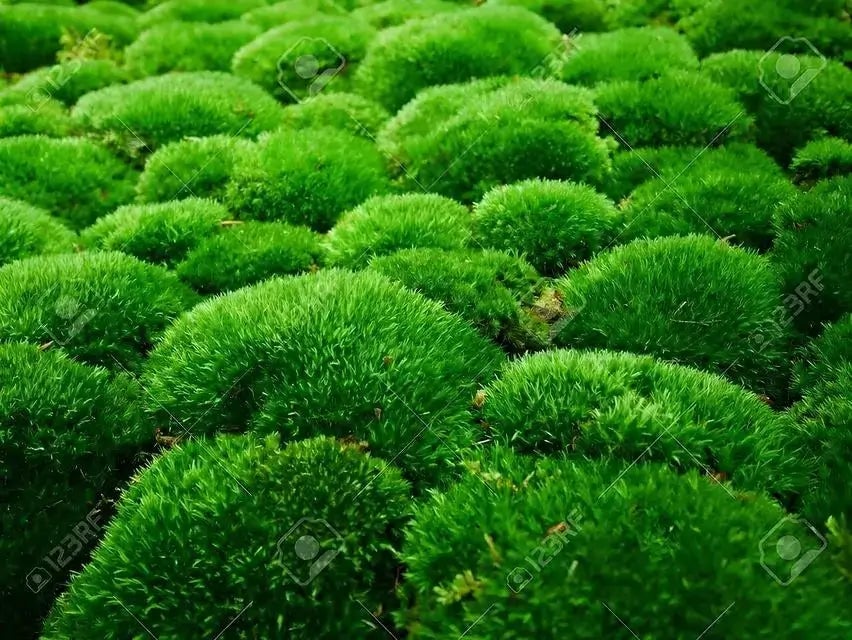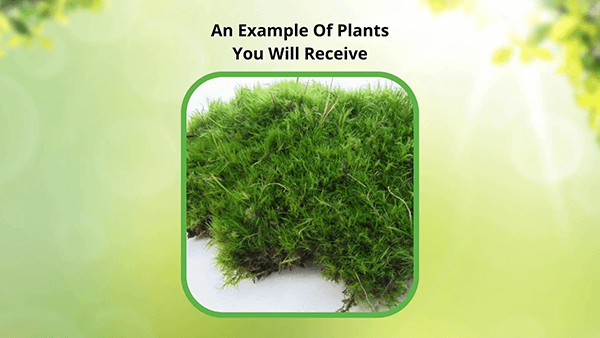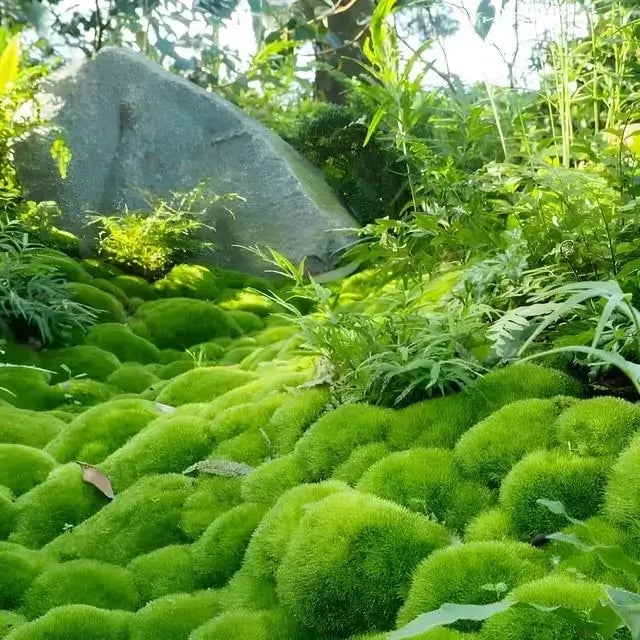



Cushion Moss
This plant ships:
NowWe sell bare root plants - click here to see what you'll receive
Cushion moss is a low-growing, densely matted plant that forms a lush green ground cover in shady, moist environments. It's a versatile evergreen ground cover with numerous air-cleaning benefits. Its distinctive formation and adaptability make it a favored choice for enhancing outdoor spaces in water gardens and features, shade, and damp areas.
Cushion Moss (Leucobryum glaucum) Has Breathtaking Looks
Cushion Moss grows in thick, pillow-shaped mounds that are at least as big as a pincushion. These mounds can grow up to a foot in diameter. The new stems are long and pointed in winter or late autumn. Their beaked, blunt end caps and golden to reddish brown shades are telltale signs of maturity. They are vibrant green and also form dense, round cushions. They can split off and grow into new plants, a process known as fragmentation, which helps with asexual reproduction. This is how the plant can cover such a large area so fast.
The dense foliage that this form provides shelter and protection to various animals and tiny organisms. They retain moisture, creating ideal microclimates for insects, spiders, and other invertebrates. These microclimates help to build more significant habitats for larger species. They even act as a thick layer of insulation, reducing the impact of severe temperatures and creating a steady habitat for creatures who live on or under it. Because of their insulating qualities and gentle texture, they are a favored nesting material for many tiny animals and birds.
They absorb pollutants from the air, making them excellent natural air purifiers. Tiny, hair-like structures known as rhizoids and papillae cover the surface, serving as a net for airborne dust and catching it on the surface. The structure then uses capillary action and microbial processes to digest and decompose the particles after they are within it. They also have bacteria that can transform pollution into usable biomass.
Get Rid of Weeds With Cushion Moss
It is an excellent weed suppressor because it can form a physical barrier, release allelopathic chemicals, and shade the soil. Their enhanced ability to better compete with weeds for nutrients also contributes to their weed suppression abilities. In addition to stabilizing the dirt and stopping plant colonization, their thick growth habit further prevents weed seed germination.
Cushion Moss, also known as a pincushion, is a type of low-growing plant that is very densely packed together. Its primary role is to serve as an evergreen covering over the ground, offering numerous cleansing benefits for the air. It’s highly adaptable to various gardens and landscapes and naturally welcoming and inviting. Beyond its lush appearance, it also serves a primary role in the ecosystem of many frogs, insects, and spiders. It can help contribute to a healthy and vibrant garden.
Add Cushion Moss For A Vibrant, Lush Feel To Your Garden
Officially called leucobryum glaucum, it is native to the forests of North America. It thrives the best in moist areas with plenty of shade but can do well with minimal sunlight. It also prefers soil that is a bit more sandy and less dense. You’ll most commonly find it in moist gardens, rock gardens, alongside pathways, or near water areas.
It is instantly recognizable for its green color, which sometimes has a tint of blue. The drier it gets. However, the more the blue tint begins to fade, the lighter the green will become. In many ways, it is like nature’s carpet. It’s very soothing to step barefoot over and help you connect with nature. For this reason, its luxuriant appearance can turn a dull landscape into a pleasant and soothing one.
What is the Appeal of Cushion Moss To Gardeners
It offers many benefits for gardeners beyond its plush feel or verdant appearance. It acts as a natural mulch to keep weed growth to a minimum and help the soil beneath it retain moisture. This allows the soil in gardens to remain hydrated even during drought. Another benefit to it is how low maintenance it is. It only requires minimal pruning and watering to maintain its vibrancy. This makes it a good choice for those who want a lush landscape that doesn’t require much care. It is a low-maintenance plant that will help protect your soil, promote a healthy ecosystem, and create a welcoming environment for your landscape or garden.
Does Cushion Moss Spread
Indeed, cushion moss grows on its own, though at a slow rate when compared with other ferns. It spreads outwards from the middle and thus forms a thick and rich cover ideal for ground topping or even ornamental purposes.
What Are The Benefits Of Cushion Moss
Cushion moss is a favorite when it comes to providing texture to both interior and exterior designs. The moss enhances air quality and soil moisture retention while being an economical, shade-tolerant, low-maintenance solution to grass.
Does Cushion Moss Need Water Cushion moss needs moisture for it to grow. It doesn't have to be soaked, but it does have to be moist enough to keep the green still bright and 'alive.' But what has to be avoided is overwatering as this causes the plant to develop mold.
Does Cushion Moss Require Sunlight
Cushion moss prefers to grow in indirect light conditions or only in partial shade. It does not need to be exposed to direct sunlight, which could dehydrate the plant and ruin the tissue.
Can Cushion Moss Grow On Plastic
While cushion moss does not actually grow on plastic itself, it can if it's preceded by a layer of substrate of some sort, such as soil.
| Planting zone | [4, 5, 6, 7, 8, 9, 10] |
|---|---|
| Height At Maturity | Under 6 Inches |






Cushion Moss
This plant ships:
Now| Planting zone | [4, 5, 6, 7, 8, 9, 10] |
|---|---|
| Height At Maturity | Under 6 Inches |

